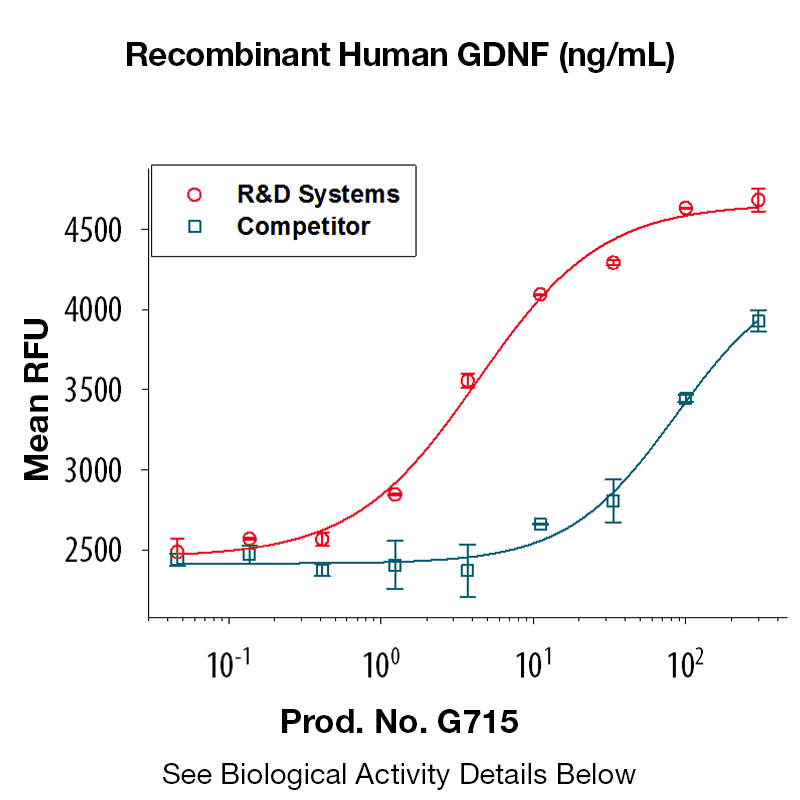Recombinant Human GDNF
Data
- -
- -
BackgroundGlial cell derived neurotrophic factor, also known as GDNF is a glycosylated, disulfide-bonded homodimer that is a distantly related member of the transforming growth factor-beta superfamily.1 GDNF potently promotes the survival of many types of neurons, most prominently, dopaminergic and motorneurons. GDNF regulates kidney development and spermatogenesis, and it affects alcohol consumption.2 Protein DetailsPurity >97% by SDS-PAGE and analyzed by silver stain. Endotoxin Level <1.0 EU/µg as determined by the LAL method Biological Activity The biological activity of Human GDNF was determined by its ability to support the survival and stimulate neurite outgrowth of cultured embryonic chick dorsal root ganglia neurons (Davies, A.M., 1989, Neurotrophic Factor Bioassay Using Dissociated Neurons, Nerve Growth Factor, Rush, R.A., ed., John Willey and Sons, Ltd., p.95). The expected ED<sub>50</sub> for this effect is typically 1 - 3 ng/ml. Protein Accession No. Amino Acid Sequence rg qrgknrgcvl taihlnvtdl glgyetkeel ifrycsgscd aaettydkil knlsrnrrlv sdkvgqaccr piafdddlsf lddnlvyhil rkhsakrcgc i N-terminal Sequence Analysis Arg109 State of Matter Lyophilized Predicted Molecular Mass The predicted molecular weight of Recombinant Human GDNF is Mr 11.6 kDa. Predicted Molecular Mass 11.6 Formulation This recombinant protein was 0.2 µm filtered and lyophilized from modified Dulbecco’s phosphate buffered saline (1X PBS) pH 7.2 – 7.3 with no calcium, magnesium, or preservatives. Storage and Stability This lyophilized protein is stable for six to twelve months when stored desiccated at -20°C to -70°C. After aseptic reconstitution, this protein may be stored at 2°C to 8°C for one month or at -20°C to -70°C in a manual defrost freezer. Avoid Repeated Freeze Thaw Cycles. See Product Insert for exact lot specific storage instructions. Country of Origin USA Shipping Next Day Ambient NCBI Gene Bank Applications and Recommended Usage ? (Quality Tested by Leinco) ELISA Sandwich: This antibody is useful as the capture antibody in a sandwich ELISA. The suggested coating concentration is 5 µg/ml (100 µl/well) µg/ml. Flow Cytometry: PN:A106 Flow Cytometry: It is recommended to use the indirect method for signal enhancement when enumerating cells expressing CXCR5. A suggested method would be to stain cells expressing CXCR5 with approximately 10 µl per test. A typical test sample constitutes approximately 50 µl of packed whole blood or 1 x 105 continuous passage or activated cell cultures that have been centrifuged at 500 X g for five minutes. Labeling of the cells with the biotin conjugate should be followed by PN:A104, resuspended in 200-400 µl of 1X PBS. References & Citations1. Collins, F. et al. (1993) Science 260: 1130 2. Ron, D. et al. (2008) Proc. Natl. Acad. Sci. U.S.A. 105: 8114 Technical ProtocolsCertificate of AnalysisIMPORTANT Use lot specific datasheet for all technical information pertaining to this recombinant protein. |
Related Products
- -
- -
Prod No. | Description |
|---|---|
G663 | |
G116 | |
G639 | |
G715 | |
G141 |




